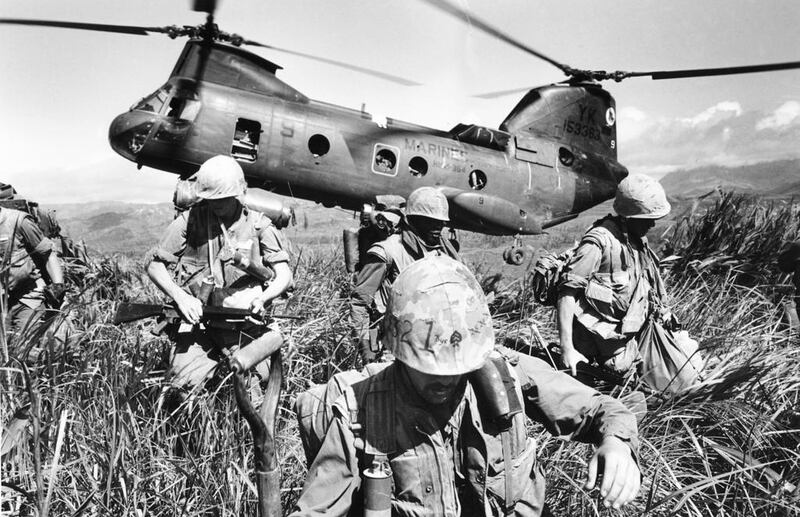Some of the most iconic images of the last half century, reproduced endlessly in films, were taken in Saigon 40 years ago at the end of this month.
Who is not familiar with the photographs of helicopters taking off from what was then the capital of South Vietnam in April 1975, as American personnel and thousands of desperate Vietnamese attempted to evacuate while the armies of the north broke into the city? It marked the end of the Vietnam War, a conflict that cost the lives of at least one million Vietnamese, with one estimate putting the figure at over three million.
Given the enormous loss of life, the well-documented atrocities by US forces and the long-term devastation caused by the massive use of Agent Orange to deprive the Viet Cong of forest cover, it is quite remarkable just how friendly relations are now between the US and Vietnam. Diplomatic relations were established in 1995, and a “comprehensive partnership” was launched in 2013.
It is a measure of how close the two countries have become that Vietnamese diplomats would rather the old enemy was a more forceful presence in the region. They are hoping Washington will check China’s seemingly inexorable advance across the South China Sea, much of which it claims as its own territorial waters.
Much as the amity is to be welcomed, the 40th anniversary of the war should also remind us of how misguided much of America’s pushback against Communism was, over many decades – and to what catastrophes it led.
Vietnam was one example. For the leaders of the north, the war with the Americans was a continuation of the anti-colonial struggle against their former masters, the French. Indeed, it was General Giap, the victor of the battle of Dien Bien Phu (which led to France surrendering and withdrawing), who was in command of North Vietnam’s armies against the Americans.
The latter, however, couldn’t see beyond “the red threat” and preferred to support a series of corrupt and chaotic military dictatorships in South Vietnam.
It is not as though they were unaware of the popularity of Ho Chi Minh, the North Vietnamese leader, throughout the whole country.
As Dwight D Eisenhower, the US president, wrote in his memoirs: “I have never talked or corresponded with a person knowledgeable in Indo-Chinese affairs who did not agree that had elections been held as of the time of the fighting [in 1954], possibly 80 per cent of the population would have voted for the Communist Ho Chi Minh as their leader.” And that, apparently, could not be allowed.
It was a similar calculation that led the US to support the 1973 coup against Chile’s president, Salvador Allende. That was followed by 17 years of rule by a military junta headed by the late General Augusto Pinochet. Allende had been democratically elected, but America preferred a dictatorship that became a byword for repression – all because Allende was a Marxist.
The list of dictators the US supported in Latin America alone is too long to list here, but the policy of favouring anyone on the right over politicians deemed too friendly to Communist powers was applied around the world, and often with disastrous results.
It is quite possible, if not likely, for instance, that if General Lon Nol had not overthrown Cambodian ruler Prince Norodom Sihanouk in 1970 – a coup in which CIA involvement was alleged – Cambodia might well have been spared the horrors of the Khmer Rouge.
For it was this act that precipitated a civil war in which the US backed Lon Nol, but who eventually fled after Communist troops, initially aligned with Sihanouk, surrounded the capital in 1975.
Sihanouk had tried to steer a course between “American imperialism and Asian Communism”. It was America’s man, Lon Nol, “Who obliged me to choose”, he said.
Sihanouk’s middle way could have saved Cambodia from a genocide in which one-fifth of the population perished. But it wasn’t sufficiently anti-Communist for his replacement’s backers.
The Cold War is long over, of course. But this aspect of it is one that should be remembered as the 40th anniversary of the Vietnam War’s end is marked.
What a wasteful, pointless conflict that was, and so at odds with America’s continued commitment to spreading freedom and democracy around the world.
For either freedom or democracy to mean anything, a people’s ability to choose a government of whatever political stripe they want is a basic requirement, even when that government is not to the taste of America.
But for too long it appeared that American rhetoric was undermined by its actions: stolen elections were ignored, and when they were free, it was more a case of “you can vote for whoever you like – so long as we approve”. Such impressions have not been forgotten in many of the countries affected, and still fill the wells of suspicion about America’s eagerness for forceful interventionism abroad.
Rarely can there be a clearer example of muddled US thinking over democracy than the 2006 Palestinian elections. Hamas won that contest by a considerable margin, only to be told by the Bush administration that it would not deal with the group. Hamas was subsequently declared a terrorist organisation by the US.
It is a lesson worth bearing in mind when images of the fall of Saigon resurface, whether in print, on television news or in the numerous Vietnam films. Ask yourself: why did those millions die? If it wasn’t for democracy, then for what?
Sholto Byrnes is a senior fellow at the Institute for Strategic and International Studies, Malaysia





